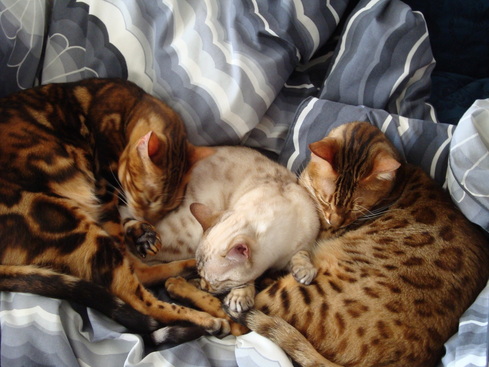
The Bengal is a relatively new breed of cat which was first bred in the USA and was originally created by crossing an Asian Leopard Cat with a domestic cat. The domestic Bengal derives its name from the Latin name of its wild ancestor, Felis Bengalensis (Asian Leopard Cat). Whilst the domestic Bengal is similar in appearance to the Asian Leopard cat and its genetic makeup contains a contribution from that wild cat species, its temperament is however purely domestic. The goal in developing the domestic Bengal cat breed was to preserve a strong physical resemblance to its beautiful wild ancestor and, at the same time, the new domestic breed was designed to be a pleasant and trustworthy family companion. Therefore, the conformation of the Bengal is definitely reminiscent of its ancestors.
Bengals are intelligent and athletic and seem to look on everything around them as "can this be played with?". Their playful natures makes them ideal companions for the younger members of the family, who usually can do anything with them. The young humans can act out their fantasies and have the companion they want. So many times we have seen a young human walking around with an adoring Bengal marching alongside sharing the moment.
The Bengal is a large, sleek and very muscular cat with its hind-quarters slightly higher than its shoulders with a thick tail that is carried low. The Bengal should be alert and affectionate and its wild appearance is enhanced by its distinctive spotted or marbled coat which should be thick and luxurious. There can be both Black or Brown Spotted and Black or Brown Marbled Bengals, as well as Snow Spotted and Snow Marbled Bengals.
Bengals have a unique pattern which is not found in other breeds of cat.. There is no other breed of cat which displays the gold or pearl dusting effect (glitter) of the Bengal. The texture of the coat is unique. It has the feel of satin or silk. In recent years, as the breed has moved further away from its origins, breeders have been able to develop more distinctive rosetted patterns. This rosetting has enhanced the uniqueness of the breed, as has also the recent appearance of Bengals with almost white undersides. Even the voice of a Bengal is different from that of other domestic cats. It has been described as a cooing or chirping or as a strange gravelly sound. They are a very vocal breed and have a wide vocabulary that may on occasion be quite strident especially in unfamiliar situations. This should not be confused with aggression; it is an individual means of expression. They also love to play with water! Bengals seem to have preserved the self-assurance and confidence essential to their wild ancestors whilst acquiring an affectionate disposition and an extremely energetic, playful nature. The overall impression is of a miniature leopard with a loving dependable temperament. They are extremely sociable and interact well with other household pets.
